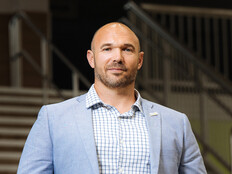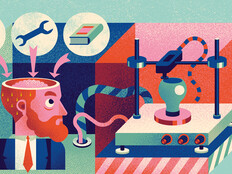The Inside Story of the STEM Curriculum at Minnesota’s First Project Lead The Way–Certified School District
Every school day, Sarah O'Connell, a senior at Kingsland High School in Spring Valley, Minn., packs a netbook in her backpack. Later in the day, she opens that netbook, connects it to hospital-grade medical equipment, and works on echocardiograms, blood pressure analysis or protein mapping, much as college and medical school students do.
For O'Connell, it's a way to advance her studies and perhaps put her a step or two closer to becoming a doctor. For Kingsland Public Schools, it's standard operating procedure — part of the Kingsland STEM Initiative in which all KPS students in grades four through 12 can participate.
Last November, KPS became the first district in Minnesota to earn certification in three curriculum programs developed by Project Lead The Way (PLTW), an Indianapolis-based nonprofit that works with U.S. schools and districts to elevate science, technology, engineering and mathematics (STEM) education. Those that pass PLTW's rigorous review acquire new classroom equipment and become certified providers of its engineering, biomedical science and technology programs, delivered via PLTW's Virtual Academy. (For more on PLTW, see sidebar, "Project Brief.")
Most districts choose to seek PLTW certification in one or two programs, but KPS decided to pursue all three, all at once. Superintendent John McDonald, who went through the PLTW registration process with another district a few years ago, says PLTW personnel visit districts and schools that are seeking certification and evaluate them in 10 areas. "It's an education audit, and as you get ready, you go through steps that include reviewing your curriculum, checking student work, interviewing teachers and administrators, and setting up business partner teams," he explains. "If you've ever had to deal with the IRS, it's like that — but in a very good way."
Once a school finishes the process, its courses become college certified and earn students credit at nearly 70 institutions nationwide. "It's very similar to the College Board's Advanced Placement program," McDonald continues. "Students perform on end-of-year exams in a way that shows they have the skills in those areas." It's also very rewarding for the schools to know they're offering such a high-level curriculum, he adds.
"I really like how challenging it is," says O'Connell, who's enrolled in Kingsland High School's biomedical program. "Our teacher facilitates learning but doesn't lead us by the hand. We figure things out on our own, and we do a lot of hands-on work. We don't just sit and take notes."
Tops in Tech
Getting certified requires investing in a lot of new technology. According to Technology Coordinator Bob Tieffenbacher, KPS teachers and students have access to seven Planar PL2210W LCD televisions, 60 Acer LCD monitors and 62 Lenovo ThinkCentre desktop computers. The high school also has a computer lab with two HP EliteBook Mobile Workstations and seven Lenovo ThinkCentre desktops. KPS purchased much of this equipment with help from grants, McDonald says.
In September, the district issued every high school student an HP Mini netbook, which he or she will keep throughout the school year for use in PLTW–track courses. Kingsland Middle School students will receive netbooks for the 2013–2014 school year. Kingsland Elementary School students work on school-issued tablets.
O'Connell says having her own netbook is a tremendous advantage. "It's nice to have everything at my fingertips," she explains. "I don't have to go to the computer lab. I can work at home, at sports practices or wherever I am." Students in the engineering and technology tracks enjoy the same benefits, specific to those courses of study.
From STEM to Stern
Technology is key to making the PLTW–certified programs work, and teachers say that enabling each student to have his or her own school-issued device is essential — particularly because some may not have one at home. "Our goal is to have one-to-one netbooks and tablets for students in kindergarten through 12th grade in the near future," McDonald says. "We have the infrastructure to support that. We can have 500 devices using the Internet at one time, in fact."
The district also has the necessary teacher support to make its STEM programs successful, thanks to PLTW–provided training that's paid for by KPS. "They work something like 10 hours a day," McDonald says of the instructors who give up two weeks of their summer to be trained in how to teach a PLTW course. "It's exhausting and challenging, but also very enjoyable. It's an investment in our school and our students."
Such investments are paying off. "We have students doing vital signs and EKGs and recording data — things I didn't do in college," he continues. "They feel challenged. They're learning to problem-solve, communicate and collaborate. That's how this program is built."
Tieffenbacher is equally effusive in his praise of the Kingsland STEM Initiative and the teaching and learning opportunities it enables. "If you're using a textbook, by the time it gets to your building, it's already out of date," he says. "But our students are using e-books, and teachers are building their own curricula via the web. Work is turned in online. Students aren't waiting in line to print at a printer. If they finish their homework at 9:00 at night, they can send it to their teacher. If they have a question, they can email a teacher or pull up a video and watch it again. That's huge for parents who haven't experienced things like algebra or trigonometry for a while: Students can still get help at home."
It's opened a whole new world, he continues — one in which students are increasingly connected to each other, to teachers and to experts in the fields they may ultimately pursue in college and their careers. "The classroom today is so different than it was five years ago," Tieffenbacher notes. "This gives them access to anything, anytime they need it."
Project Brief
Project Lead The Way (PLTW)'s original curriculum launched in 12 New York high schools in 1997. Within a few years, PLTW programming was available to schools in 30 states.
Today, PLTW offers certified science, technology, engineering and mathematics (STEM) programming to more than 5,100 schools in all 50 states and Washington, D.C. The three curriculum programs include:
- Gateway To Technology (GTT), an assortment of nine-week units for middle school students that explore aerospace, energy, the environment, robotics, technology and other STEM-related topics;
- Pathway To Engineering (PTE), a program for high school students that explores the design process and links STEM principles through problem-solving activities; and
- Biomedical Sciences (BMS), another program for high schoolers that covers medicine, genetics and other biomedical topics through problem-solving activities.
A fourth program, for elementary school students, will be available beginning in the 2014–2015 school year.
Schools receive a complete curriculum for each program in which they're certified, along with online resources, online communities for teachers, teacher training at universities around the country, conferences for administrators and end-of-course assessments. Courses in all three programs are hands-on and project- and problem-based, focusing on both course material and developing collaborative problem-solving and thinking skills. To date, according to PLTW, more than 10,500 teachers nationwide have been trained in its specialty areas.
"Project Lead The Way changes how education happens," says Jennifer Cahill, PLTW's director of communications. "It changes the way students receive information, process that information and apply it to real life. It's not just a math and science class using a textbook and taking a test. It's a hands-on approach to the equations and those principles — and learning how they can apply to real life."







